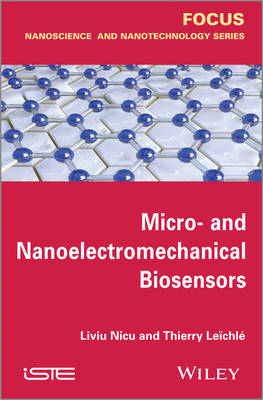
Micro-and Nanoelectromechanical Biosensors
ISTE Ltd and John Wiley & Sons Inc (Verlag)
978-1-84821-479-8 (ISBN)
Most books dedicated to the issues of bio-sensing are organized by the well-known scheme of a biosensor. In this book, the authors have deliberately decided to break away from the conventional way of treating biosensing research by uniquely addressing biomolecule immobilization methods on a solid surface, fluidics issues and biosensing-related transduction techniques, rather than focusing simply on the biosensor. The aim is to provide a contemporary snapshot of the biosensing landscape without neglecting the seminal references or products where needed, following the downscaling (from the micro- to the nanoscale) of biosensors and their respective best known applications. To conclude, a brief overview of the most popularized nanodevices applied to biology is given, before comparing biosensor criteria in terms of targeted applications.
Thierry Leïchlé is a CNRS researcher at the Laboratory for Analysis and Architecture of Systems in Toulouse, France. Liviu Nicu is a full time CNRS (National Center of Scientific Research) researcher the NanoBioSytems Group at LAAS in Toulouse, France.
INTRODUCTION vii
CHAPTER 1. TRANSDUCTION TECHNIQUES FOR MINIATURIZED BIOSENSORS 1
1.1. Definition of bioMEMS 1
1.2. Transduction techniques 2
1.2.1. Optical transduction 2
1.2.2. Electro (chemical) transduction 6
1.2.3. Mechanical transduction 10
1.3. MEMS transducers 17
1.4. One specific application of MEMS biosensors: detection of pathogen agents 20
1.5. Bibliography 25
CHAPTER 2. BIORECEPTORS AND GRAFTING METHODS 35
2.1. Types of bioreceptor 35
2.1.1. Catalytic receptors 36
2.1.2. Affinity receptors 37
2.1.3. Nucleic acid-based receptors 40
2.1.4. Molecularly imprinted polymers 41
2.2. Immobilization strategies 43
2.2.1. Adsorption and antifouling strategies 44
2.2.2. Entrapment methods 49
2.2.3. Covalent coupling 51
2.2.4. Other capture systems 54
2.2.5. Immobilization strategies: summary 56
2.3. Conclusion 57
2.4. Bibliography 57
CHAPTER 3. PATTERNING TECHNIQUES FOR THE BIOFUNCTIONALIZATION OF MEMS 65
3.1. What is surface patterning? 65
3.2. Direct biopatterning in liquid phase 66
3.2.1. Ink delivery by non-contact methods 67
3.2.2. Ink delivery by contact methods 71
3.3. Replication of patterns 80
3.3.1. Photolithography 81
3.3.2. Light-induced patterning strategies 81
3.3.3. Microcontact printing 82
3.3.4. In-flux functionalization 83
3.4. Conclusions 84
3.5. Bibliography 85
CHAPTER 4. FROM MEMS TO NEMS BIOSENSORS 93
4.1. Importance of downscaling 93
4.2. Challenges faced by NEMS for biosensing applications 95
4.2.1. Issues related to nanomechanical transducers 97
4.2.2. Issues related to the functionalization of NEMS 99
4.2.3. On the importance of packaging and sample preparation 103
4.3. Economic considerations 106
4.4. Bibliography 107
CHAPTER 5. COMPARING PERFORMANCES OF BIOSENSORS: IMPOSSIBLE MISSION? 113
5.1. Bibliography 117
INDEX 119
| Verlagsort | London |
|---|---|
| Sprache | englisch |
| Maße | 163 x 241 mm |
| Gewicht | 395 g |
| Themenwelt | Technik ► Elektrotechnik / Energietechnik |
| Technik ► Umwelttechnik / Biotechnologie | |
| ISBN-10 | 1-84821-479-0 / 1848214790 |
| ISBN-13 | 978-1-84821-479-8 / 9781848214798 |
| Zustand | Neuware |
| Haben Sie eine Frage zum Produkt? |
aus dem Bereich


